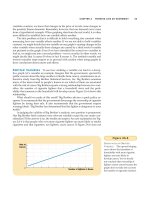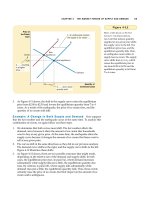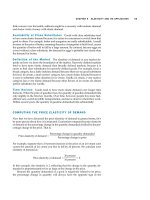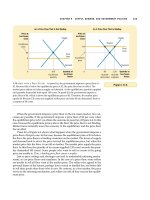Tài liệu Ten Principles of Economics - Part 24 pptx
Bạn đang xem bản rút gọn của tài liệu. Xem và tải ngay bản đầy đủ của tài liệu tại đây (224.02 KB, 10 trang )
CHAPTER 11 PUBLIC GOODS AND COMMON RESOURCES 239
buffalo roamed the continent. Yet hunting the buffalo was so popular during the
nineteenth century that by 1900 the animal’s population fell to about 400 before
the government stepped in to protect the species. In some African countries to-
day, the elephant faces a similar challenge, as poachers kill the animals for the
ivory in their tusks.
Yet not all animals with commercial value face this threat. The cow, for ex-
ample, is a valuable source of food, but no one worries that the cow will soon be
extinct. Indeed, the great demand for beef seems to ensure that the species will
continue to thrive.
Why is the commercial value of ivory a threat to the elephant, while the
commercial value of beef is a guardian of the cow? The reason is that elephants
are a common resource, whereas cows are a private good. Elephants roam
freely without any owners. Each poacher has a strong incentive to kill as many
elephants as he can find. Because poachers are numerous, each poacher has
only a slight incentive to preserve the elephant population. By contrast, cows
live on ranches that are privately owned. Each rancher takes great effort to
maintain the cow population on his ranch because he reaps the benefit of these
efforts.
Governments have tried to solve the elephant’s problem in two ways. Some
countries, such as Kenya, Tanzania, and Uganda, have made it illegal to kill ele-
phants and sell their ivory. Yet these laws have been hard to enforce, and ele-
phant populations have continued to dwindle. By contrast, other countries,
such as Botswana, Malawi, Namibia, and Zimbabwe, have made elephants a
private good by allowing people to kill elephants, but only those on their own
property. Landowners now have an incentive to preserve the species on their
own land, and as a result, elephant populations have started to rise. With pri-
vate ownership and the profit motive now on its side, the African elephant
might someday be as safe from extinction as the cow.
QUICK QUIZ: Why do governments try to limit the use of common
resources?
CONCLUSION: THE IMPORTANCE
OF PROPERTY RIGHTS
In this chapter and the previous one, we have seen there are some “goods” that the
market does not provide adequately. Markets do not ensure that the air we breathe
is clean or that our country is defended from foreign aggressors. Instead, societies
rely on the government to protect the environment and to provide for the national
defense.
Although the problems we considered in these chapters arise in many different
markets, they share a common theme. In all cases, the market fails to allocate re-
sources efficiently because property rights are not well established. That is, some
item of value does not have an owner with the legal authority to control it. For ex-
ample, although no one doubts that the “good” of clean air or national defense is
valuable, no one has the right to attach a price to it and profit from its use. A factory
“W
ILL THE MARKET PROTECT ME
?”
240 PART FOUR THE ECONOMICS OF THE PUBLIC SECTOR
pollutes too much because no one charges the factory for the pollution it emits. The
market does not provide for national defense because no one can charge those who
are defended for the benefit they receive.
When the absence of property rights causes a market failure, the government
can potentially solve the problem. Sometimes, as in the sale of pollution permits,
the solution is for the government to help define property rights and thereby un-
leash market forces. Other times, as in the restriction on hunting seasons, the solu-
tion is for the government to regulate private behavior. Still other times, as in the
provision of national defense, the solution is for the government to supply a good
that the market fails to supply. In all cases, if the policy is well planned and well
run, it can make the allocation of resources more efficient and thus raise economic
well-being.
◆ Goods differ in whether they are excludable and
whether they are rival. A good is excludable if it is
possible to prevent someone from using it. A good is
rival if one person’s enjoyment of the good prevents
other people from enjoying the same unit of the good.
Markets work best for private goods, which are both
excludable and rival. Markets do not work as well for
other types of goods.
◆ Public goods are neither rival nor excludable.
Examples of public goods include fireworks displays,
national defense, and the creation of fundamental
knowledge. Because people are not charged for their use
of the public good, they have an incentive to free ride
when the good is provided privately. Therefore,
governments provide public goods, making their
decision about the quantity based on cost-benefit
analysis.
◆ Common resources are rival but not excludable.
Examples include common grazing land, clean air, and
congested roads. Because people are not charged for
their use of common resources, they tend to use them
excessively. Therefore, governments try to limit the use
of common resources.
Summary
excludability, p. 226
rivalry, p. 226
private goods, p. 226
public goods, p. 226
common resources, p. 226
free rider, p. 228
cost-benefit analysis, p. 231
Tragedy of the Commons, p. 234
Key Concepts
1. Explain what is meant by a good being “excludable.”
Explain what is meant by a good being “rival.” Is a
pizza excludable? Is it rival?
2. Define and give an example of a public good. Can
the private market provide this good on its own?
Explain.
3. What is cost-benefit analysis of public goods? Why is it
important? Why is it hard?
4. Define and give an example of a common resource.
Without government intervention, will people use this
good too much or too little? Why?
Questions for Review
CHAPTER 11 PUBLIC GOODS AND COMMON RESOURCES 241
1. The text says that both public goods and common
resources involve externalities.
a. Are the externalities associated with public goods
generally positive or negative? Use examples in
your answer. Is the free-market quantity of public
goods generally greater or less than the efficient
quantity?
b. Are the externalities associated with common
resources generally positive or negative? Use
examples in your answer. Is the free-market use of
common resources generally greater or less than the
efficient use?
2. Think about the goods and services provided by your
local government.
a. Using the classification in Figure 11-1, explain what
category each of the following goods falls into:
◆ police protection
◆ snow plowing
◆ education
◆ rural roads
◆ city streets
b. Why do you think the government provides items
that are not public goods?
3. Charlie loves watching Teletubbies on his local public TV
station, but he never sends any money to support the
station during their fund-raising drives.
a. What name do economists have for Charlie?
b. How can the government solve the problem caused
by people like Charlie?
c. Can you think of ways the private market can solve
this problem? How does the existence of cable TV
alter the situation?
4. The text states that private firms will not undertake the
efficient amount of basic scientific research.
a. Explain why this is so. In your answer, classify
basic research in one of the categories shown in
Figure 11-1.
b. What sort of policy has the United States adopted
in response to this problem?
c. It is often argued that this policy increases the
technological capability of American producers
relative to that of foreign firms. Is this argument
consistent with your classification of basic research
in part (a)? (Hint: Can excludability apply to some
potential beneficiaries of a public good and not
others?)
5. Why is there litter along most highways but rarely in
people’s yards?
6. The Washington, D.C., metro (subway) system charges
higher fares during rush hours than during the rest of
the day. Why might it do this?
7. Timber companies in the United States cut down many
trees on publicly owned land and many trees on
privately owned land. Discuss the likely efficiency of
logging on each type of land in the absence of
government regulation. How do you think the
government should regulate logging on publicly owned
lands? Should similar regulations apply to privately
owned land?
8. An Economist article (March 19, 1994) states: “In the past
decade, most of the rich world’s fisheries have been
exploited to the point of near-exhaustion.” The article
continues with an analysis of the problem and a
discussion of possible private and government solutions:
a. “Do not blame fishermen for overfishing. They are
behaving rationally, as they have always done.” In
what sense is “overfishing” rational for fishermen?
b. “A community, held together by ties of obligation
and mutual self-interest, can manage a common
resource on its own.” Explain how such
management can work in principle, and what
obstacles it faces in the real world.
c. “Until 1976 most world fish stocks were open to all
comers, making conservation almost impossible.
Then an international agreement extended some
aspects of [national] jurisdiction from 12 to 200
miles offshore.” Using the concept of property
rights, discuss how this agreement reduces the
scope of the problem.
d. The article notes that many governments come to
the aid of suffering fishermen in ways that
encourage increased fishing. How do such policies
encourage a vicious cycle of overfishing?
e. “Only when fishermen believe they are assured a
long-term and exclusive right to a fishery are they
likely to manage it in the same far-sighted way as
good farmers manage their land.” Defend this
statement.
f. What other policies to reduce overfishing might be
considered?
9. In a market economy, information about the quality or
function of goods and services is a valuable good in its
Problems and Applications
242 PART FOUR THE ECONOMICS OF THE PUBLIC SECTOR
own right. How does the private market provide this
information? Can you think of any way in which the
government plays a role in providing this information?
10. Do you think the Internet is a public good? Why or
why not?
11. High-income people are willing to pay more than lower-
income people to avoid the risk of death. For example,
they are more likely to pay for safety features on cars.
Do you think cost-benefit analysts should take this fact
into account when evaluating public projects? Consider,
for instance, a rich town and a poor town, both of which
are considering the installation of a traffic light. Should
the rich town use a higher dollar value for a human life
in making this decision? Why or why not?
IN THIS CHAPTER
YOU WILL . . .
Consider the
tradeoff between
efficiency and
equity in the design
of a tax system
Learn alternative
ways to judge the
equity of a tax
system
Get an overview of
how the U.S.
government raises
and spends money
Examine the
efficiency costs
of taxes
See why studying
tax incidence is
crucial for
evaluating tax
equity
Al “Scarface” Capone, the notorious 1920s gangster and crime boss, was never
convicted for his many violent crimes. Yet eventually he did go to jail—for tax eva-
sion. He had neglected to heed Ben Franklin’s observation that “in this world
nothing is certain, but death and taxes.”
When Franklin made this claim in 1789, the average American paid less than
5 percent of his income in taxes, and that remained true for the next hundred
years. Over the course of the twentieth century, however, taxes have become ever
more important in the life of the typical person. Today, all taxes taken together—
including personal income taxes, corporate income taxes, payroll taxes, sales taxes,
and property taxes—use up about a third of the average American’s income. In
many European countries, the tax bite is even larger.
Taxes are inevitable because we as citizens expect the government to provide
us with various goods and services. The previous two chapters have started to
THE DESIGN OF
THE TAX SYSTEM
243









